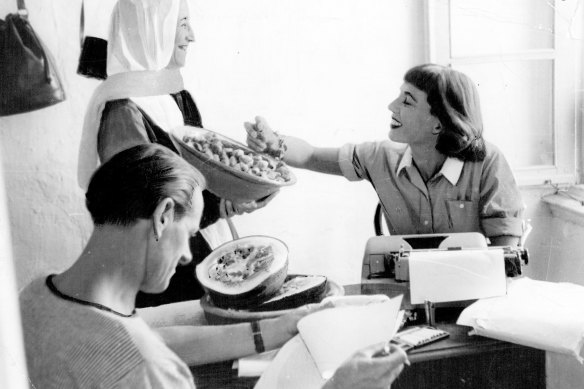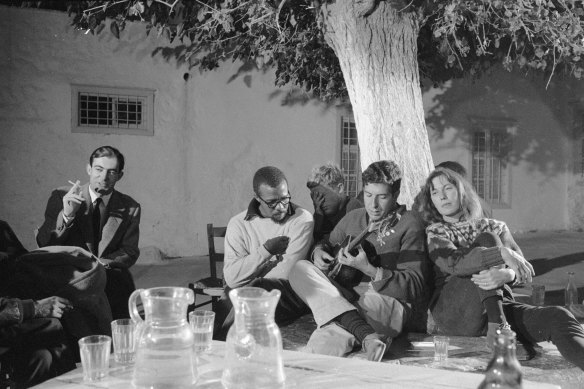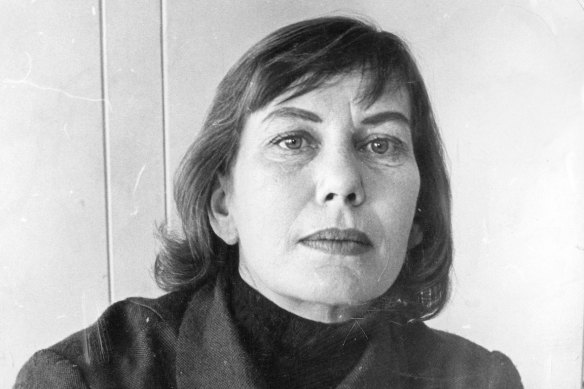It was my dream to run away to a Greek island and write a book – this year, I did it
Save articles for later
Add articles to your saved list and come back to them any time.
When I was a young journalist, my aunt Rozzie gave me two slim books with images of Aegean blue-and-white houses on the covers. Entitled Mermaid Singing and Peel Me a Lotus, both were written by Charmian Clift. Inside the former, my aunt wrote “Dearest Katie, Happy birthday maybe Greece next year?!!” It was my dream, you see, to run away to a Greek island and write a book.
Opening one at random, I read the first line: “Today we bought the house by the well.” I was captivated at once. Peel Me a Lotus reads like a letter from the very best kind of friend: clever, warm, wonderfully evocative. The house Clift bought with her husband, George Johnston, was on the tiny Greek island of Hydra, a place she called “a dream island … glowing in dream colours”. It was a “reckless romantic” decision. They wanted to “stumble off the treadmill”, raise their children in idyllic freedom, and write books.
I devoured Peel Me a Lotus in a single sitting, read Mermaid Singing as greedily, then went searching for any of her other books I could find. There were – disappointingly – few.
George Johnston and Charmian Clift in Hydra in 1963, just before the publication of My Brother Jack.Credit: Fairfax
As time went on, I read everything I could find by her or about her. I learnt that, as a child, she used to star-bake on the beach, at night, in the hope that she would turn silver. I discovered she gave birth to a daughter in secret at the age of 19 that she never saw again. And I found out that she killed herself after her husband published a novel in which he skinned and gutted her life and writings.
The distant island of Hydra seemed the crux of her life, the place where so many of her life’s dramas and disappointments occurred. Rising like a fist of stone from the glittering waters of the Saronic Gulf, it is a place of contradictions. Named for the Greek word for “water”, there is ironically little natural water on the island – it needs to be brought in by boat. It is a wild, bare place, without cars or motorbikes or trucks, and yet surprisingly chic, with designer boutiques in old sponge factories lining the quaint cobblestoned port and international art exhibitions held in elegant mansions where heroic sea captains once lived.
Charmian Clift and American poet Charles Heckstall listen as Leonard Cohen plays guitar in Hydra in October 1960.Credit: James Burke/The LIFE Picture Collection via Getty Images
As well as Charmian and George, the island has charmed many creative artists, including Leonard Cohen, Lawrence Durrell, Patrick Leigh Fermor, Sophia Loren, Sidney Nolan and Henry Miller, who wrote “aesthetically it is perfect”.
I have long wanted to go to Hydra, but somehow my life’s trade winds never blew me there. I’ve taught an inspirational writing retreat on Skyros, sailed on a catamaran around Minos, swum in the seafoam of Kythera where Aphrodite was born, and written a novel set during the Nazi occupation of Crete, but not once have I walked in the footsteps of one of my most revered Australian women writers.
This year, I vowed, I will go to Hydra. After all, this year is the anniversary of her birth, 100 years ago.
Charmian Clift was born on August 30, 1923 in Kiama, a seaside town once described as the Sleepy Hollow of New South Wales. Her childhood was difficult, her “stormy petrel” nature chafing against the constraints of the times. She tried many times to write a novel inspired by her life. First in a fragmentary manuscript entitled Greener Grows the Grass, in which her alter ego, Christine Morley, wanted to “fling off the dragging years of dependence and get on with the big adventure”. Later, Charmian adopted the name Cressida in The End of the Morning, also unfinished. She dreamt of wider horizons, of being a writer.
The outbreak of World War II opened up opportunities for her. She edited an army magazine, wrote short stories and, in 1946, joined The Argus newspaper in Melbourne. It was there that she met George Johnston, a famous war correspondent. He was 35 and married with a child. She was 23. Their affair caused a scandal. Charmian was fired, and George resigned in protest, divorced his wife and moved back to Sydney. He and Charmian were married in Manly in 1947, and worked together on the book now known as High Valley, based on George’s wartime adventures in the mountains of Tibet.
‘[They] drank more than other people, they wrote more … they cursed more, they blessed more … they were an inspiration.’
“George and Charmian would be sitting at the old deal table … each with a typewriter, going for their lives,” Charmian’s sister Margaret recalled. “George would be typing away, typing away, typing away, almost singing as he’s going … Charmian would do a little bit, think, tear it up, chuck it in the wastepaper basket, get up and walk around, stalk around … but when she put it down, it was right.” They would then read each other’s work, commenting and criticising, until they had a finished product they agreed on.
In May 1948, High Valley won The Sydney Morning Herald literary prize. Newspaper headlines declared “Journalist, wife win novel prize”. Later Charmian observed, “Most people didn’t think I’d had much to do with it.”
Over the next few years, she co-authored another two books with her husband, the last on the small Greek island of Kalymnos. Her first memoir, Mermaid Singing, was also written there. In 1954, they decided to move to Greece and try to make their living from their writing. It was a risky move. Charmian was then pregnant with her third child, who was to be “the first foreign child ever to be born on the island”. It was a hard life. There was no bathroom, no electricity, no heating except a three-legged tin filled with embers. Despite all this, Charmian is filled with exultation: “I think that no beauty has ever been as true for me as this … rocks and sea and … mountains that rush up between the blue and the blue, skirted only with austere white terraces of houses simplified to the purest geometry of planes and angles. It seems to me that we’ve become simplified too, living here.”
Yet tensions were boiling away in their seemingly perfect life.
Their poverty, the need to write books that would sell, the constant difficulty with the drains, all made every day a struggle. Even worse, Charmian could not find a publisher for Peel Me a Lotus, which was rejected more than 10 times. This was partly because of her unflinching candour, the fact she wrote about drains as well as dancing villagers. She was trying to write a novel, but as she peeled beans, fanned the charcoal fire, rinsed diapers and sifted the lentils for pebbles, the house reverberated with “the dull thudding of George’s typewriter up in the studio”.
Charmian Clift, on her return to Sydney in 1964.Credit: Nine
Their marriage was in trouble. Both were drinking heavily, and George was always sick (he was soon to be diagnosed with tuberculosis). There were endless financial worries, infidelities, arguments, jealous rages, and the constant struggle to find time to write. Leonard Cohen wrote: “[They] drank more than other people, they wrote more, they got sick more, they got well more, they cursed more, they blessed more … they were an inspiration.”
In the bitterly cold winter of 1962, Charmian put aside her own autofiction to help George write his, the autobiographical novel My Brother Jack. Charmian “sat on a stone step on a cushion and we talked and talked and remembered and remembered and I wrote”, George explained. His notebook for the novel had many pages written in Charmian’s distinctive bold handwriting. Most startlingly, the character of Cressida Morley – the name Charmian had chosen for her alter-ego – stepped out of her pages and into his: a girl with a laughing mouth and luminous green eyes, “more dangerous than a bomb”.
Later, Charmian applied for a literary fund fellowship, writing that her project was “about a girl called Cressida Morley, who has appeared already in My Brother Jack, but I invented her first”.
George’s novel was published in March 1964 to universal acclaim, and went on to win the Miles Franklin award. Charmian’s extensive contribution was never publicly recognised. He flew back to Australia for the book’s launch, and Charmian was left to pack up and sell her dream house on her dream island. Ahead lay a very different life. She would compose no more novels, no more enchanting memoirs. Instead, she would accept a role writing a weekly column for The Sydney Morning Herald, and work on the script for the television series of My Brother Jack that aired on the ABC in 1965.
Her husband, meanwhile, wrote Clean Straw for Nothing, its sequel. Lines were lifted almost word for word from Charmian’s journal, without attribution. And her alter-ego Cressida Morley’s only role is that of a treacherous, promiscuous wife. Her writing scrubbed out. Rendered meaningless. On the back of one of the notebook pages, Charmian wrote: “she also has a life in a vertical position”.
In July 1969, a month before the publication of Clean Straw for Nothing, she took a fatal overdose of her husband’s barbiturates, writing in her note to George: “I am sure you will have a most successful and distinguished career.” Soon afterwards, he won the Miles Franklin award for the second time.
This year I went to Hydra at last, that dream island. The soaring mountains are ablaze with spring colour, and a sweet-faced donkey carries panniers of white flowers for a wedding. The landmarks of a place I have never been before are achingly familiar. The small stone cafe on the waterfront where Charmian and friends used to gather to drink and gossip and wait for the mail in hope of a royalty cheque. The statue of the surly lion that “crouched pale and simpering” in the square. The gnarled olive tree at Douskos Tavern where Leonard Cohen first took up a guitar, borrowed from the proprietor.
I walk the crooked, narrow laneways, looking for the house by the well. When I find it, I lay a sprig of jasmine upon the doorstep. You are remembered, I tell Charmian. Your words are read.
The harbour in Hydra in the present day.Credit: Getty Images
Then I sit and drink a glass of wine by the harbour, in the same place she drank so many, and read Peel Me a Lotus one more time. I want to remember her as she was on Hydra, when it was “summer-time, play-time, easy-living time, lotus-eating time”. I want to remember her and George, tiptoeing “out of the dark house through the lanes … until we come to the fig tree. Silently we descend to the dark water, silently leave our pale, crumpled heap of clothes, silently slip into the wet black silk where the briny stars wake at a movement and catch and cling and stream slow trails from our nakedness, from breast and foot and fingertip that move again with wonder and delight, made marvellous by the night and the sea.”
Kate Forsyth is an award-winning author whose novel The Crimson Thread, a reimagining of the minotaur in the labyrinth myth set on Crete during World War II. In June 2024, she is conducting a boutique literary tour to Athens, Hydra and Crete with Better Read Tours.
To read more from Spectrum, visit our page here.
The Booklist is a weekly newsletter for book lovers from books editor Jason Steger. Get it delivered every Friday.
Most Viewed in Culture
From our partners
Source: Read Full Article



